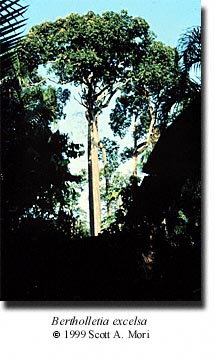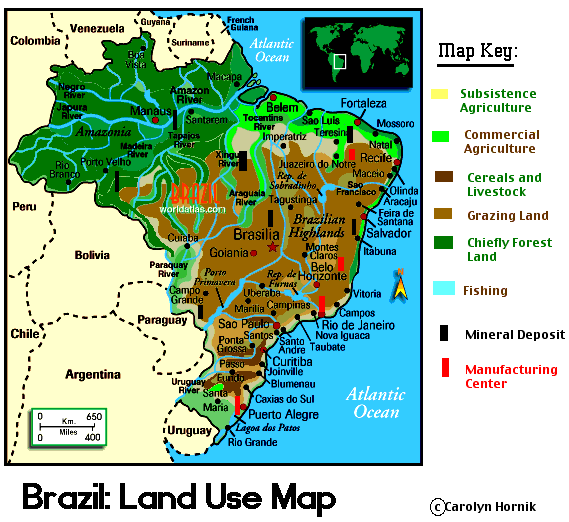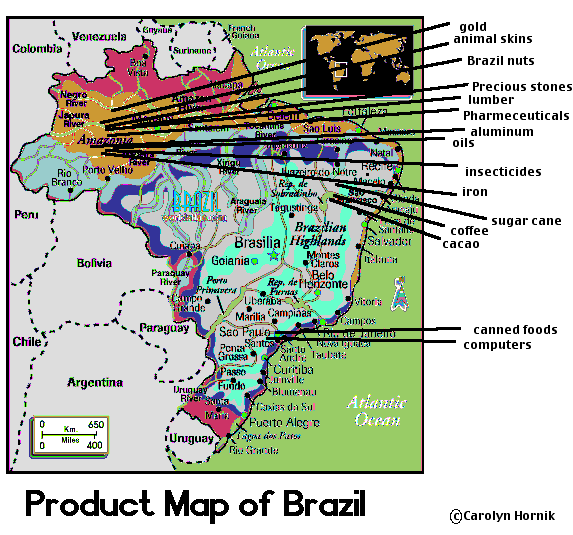| Carolyn Hornik | Unit: Virtual Tour of
Brazil
|
| Carolyn Hornik | Unit: Virtual Tour of
Brazil
|
 |
1. To appreciate the gifts of natural resources on our planet and foster ways to protect them.
2. To develop an awareness of the natural resources that are found in Brazil.
3. To develop the concept that the geographical features of a a region have an effect upon the natural resources that will be found in the region.
4. To develop research skills using the Internet.
5. To organize thoughts into a written and oral presentation.
Standards Addressed:
1. Understand the patterns and networks
of economic interdependence on Earth's surface.
2. Understand how human actions
modify the physical environment.
3. Understand how physical systems
affect human systems.
4. Understand how people in various regions of Latin American affect and area affected by their physical environment.
5. Use a variety of maps, globes, atlases, and other geographic tools to analyze the impact of geography on people and nations of the Western Hemisphere.
6. Explain the impact of technology on the environment, economies, and people of Latin America.
7. Describe the ways in which individual, groups, and governments make choices, in order to meet their needs and wants when faced with scarce resources.
8. Participate in group meetings.
5. Prepare and delivers presentations.
Setting:
The "Government Cooperative Learning Group" will participate in the activities listed in this lesson. Roles will include researchers who will find information online using web sites chosen by the teacher, recorder who will record the important information found by the researchers (information may be recorded using a word processing application such as Learning Company's Student Writing Center or Microsoft Word), illustrators who will be responsible to find online photos (from web sites that will be prescreened by the teacher) or create illustrations of the topics researched by the group using a drawing and painting application such as Kidpix, reporters, who share the information with the class both in oral reports and in written reports, and web designers who will place the textual information and graphics onto a web site for the class Virtual Travel Brochure.
Vocabulary:
Dictionary.com may be used to introduce and define the vocabulary words.
| natural resources | petroleum | environment | product | hydropower | timber | emergent layer |
| bauxite | canopy | epiphyte | mammal | invertebrate | understory | forest floor |
computer with Internet capabilities, word processing application, drawing and painting application, web writing application such as Netscape Navigator or Microsoft FrontPage, printer.
Motivation:
Look at the land use map of Brazil to answer the questions.
 |
1. In which areas of Brazil would agricultural land use be found. What inferences can you draw about the natural resources that might be found in these areas?
2. In which areas are used for grazing livestock. What natural resources do you think might be found there?
3. Where are the forest lands found? What natural resources would we find there?
4. Where are the fishing areas? What natural resources do you think we'd find there?
Development:
1. Students use the following web sites to answer the questions below.
1. http://eia.doe.gov/emeu/cabs/brazil.html
This web site gives information on Brazil's resources such as oil, coal, natural gas, and hydroelectric power.
2. http://nybg.org/bsci/braznut/
This web site provides information about the Brazil nut tree.
3. http://cesa10.k12.wi.us/Ecosystems/rainforests/plants/index.htm
Plants of the rainforest can be described here by 5th grade students.
4. http://members.tripod.com/amazon/plants.html
Get a description of rain forest plants at this web site.
5. http://junglephotos.com/amazonanimals/animlinkpage_images/animallinks.html
Use this site to get colorful photos of rain forest animals.
6. http://encarta.msn.com/find/related.asp?pg=7&ti=761554342&ct=13
Find out about Brazil's minerals at this site.
7. http://encarta.msn.com/find/related.asp?pg=7&ti=761554342&ct=15
Read about Brazil's agricultural crops, birds, fish, flowers and herbs, fruits and vegetables, invertebrates, mammals, medicinal plants, and trees and shrubs.
8. http://pbs.org/journeyintoamazonia/teacher_chico.html
This is a terrific resource. It includes interactive games, colorful photos, teacher resources, and much information related to the Amazon Rain Forest.
9. http://eduweb.com/amazon.html
This site illustrates some basic physical and human geography of the Amazon.
10. http://library.thinkquest.org/20248/inicio.html
Amazon Interactive - This site describes provides ecological information about the Brazilian area of the Amazon Rainforest.
11. http://dpi.inpe.br/grid/quick-looks
Amazonia From Space - This site provides images of the effects of land forestation in Brazil.
12. http://tqjunior.thinkquest.org/5128/
Exploring the Vast Amazon - This web site provides information on tribes, location, environmental and conservation issues, and most of all, animals of the Amazon.
13. http://ens.lycos.com/ens/sep2000/2000L-09-12-10.html
This web site includes colorful photos and information about projects to protect Brazil's natural resources. Photos include wet lands and rain forest.
| 1. What minerals are found in Brazil? | In which parts of the country are they found? | Why are they important? |
| 2. What animals are found in Brazil? | In which parts of the country are they found? | Why are they important? |
| 3. What forest areas are found in Brazil? | In which parts of the country are they found? | Why are they important? |
| 4. What fishing areas are found in Brazil? | In which parts of the country are they found? | Why are they important? |
| 5. What agricultural areas are found in Brazil? | In which parts of the country are they found? | Why are they important? |
| 6. What plants are found in Brazil? | In which parts of the country are they found? | Why are they important? |
| 7. Which fossil fuels are found in Brazil? | In which parts of the country are they found? | Why are they important? |
| 8. What are water resources found? | In which parts of the country are they found? | Why are they important? |
Summary:
From the information obtained in the research phase of this lesson, oral and written reports will be produced and shared with class. These reports will include pictures and drawings as visual aids. In addition, a product map can be made. (This can be made of papier mache or modeling clay) The map key will list the products made in Brazil from the natural resources found there and name the areas in which the products are made.
 |
Students will be evaluated on their use of the Internet to find information about Brazil's people and synthesize that information to produce oral and written reports. Students will also be evaluated on their choice and use of visual aids, including the product map they made, and their ability to communicate the information in their reports to the class in their presentation.
Follow Up:
1. Students play Amazon Explorer, an interactive game about the rain forest on http://pbs.org/journeyintoamazonia/web.html
2. Lessons on
graph interpretation may be done using the graphs found at http://eia.doe.gov/emeu/cabs/brazil.html
. Questions to answer might include: Does Brazil's consumption of petroleum
match its production? How has the consumption of petroleum changed in the
years between 1980 and 2000?